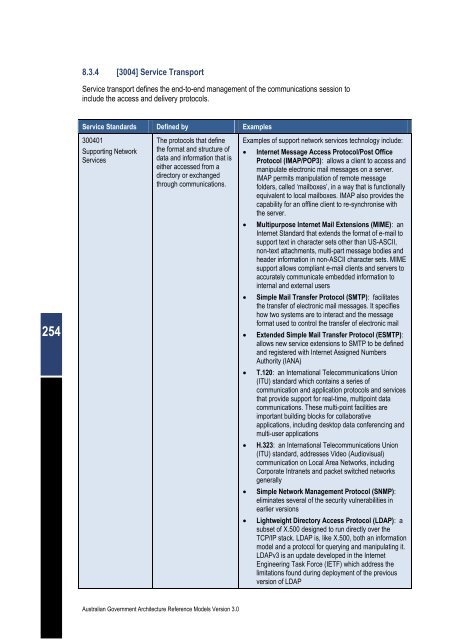Australian Government Architecture Reference Models Version 3.0
Australian Government Architecture Reference Models Version 3.0
Australian Government Architecture Reference Models Version 3.0
You also want an ePaper? Increase the reach of your titles
YUMPU automatically turns print PDFs into web optimized ePapers that Google loves.
254<br />
8.3.4 [3004] Service Transport<br />
Service transport defines the end-to-end management of the communications session to<br />
include the access and delivery protocols.<br />
Service Standards Defined by Examples<br />
300401<br />
Supporting Network<br />
Services<br />
The protocols that define<br />
the format and structure of<br />
data and information that is<br />
either accessed from a<br />
directory or exchanged<br />
through communications.<br />
<strong>Australian</strong> <strong>Government</strong> <strong>Architecture</strong> <strong>Reference</strong> <strong>Models</strong> <strong>Version</strong> <strong>3.0</strong><br />
Examples of support network services technology include:<br />
� Internet Message Access Protocol/Post Office<br />
Protocol (IMAP/POP3): allows a client to access and<br />
manipulate electronic mail messages on a server.<br />
IMAP permits manipulation of remote message<br />
folders, called ‘mailboxes’, in a way that is functionally<br />
equivalent to local mailboxes. IMAP also provides the<br />
capability for an offline client to re-synchronise with<br />
the server.<br />
� Multipurpose Internet Mail Extensions (MIME): an<br />
Internet Standard that extends the format of e-mail to<br />
support text in character sets other than US-ASCII,<br />
non-text attachments, multi-part message bodies and<br />
header information in non-ASCII character sets. MIME<br />
support allows compliant e-mail clients and servers to<br />
accurately communicate embedded information to<br />
internal and external users<br />
� Simple Mail Transfer Protocol (SMTP): facilitates<br />
the transfer of electronic mail messages. It specifies<br />
how two systems are to interact and the message<br />
format used to control the transfer of electronic mail<br />
� Extended Simple Mail Transfer Protocol (ESMTP):<br />
allows new service extensions to SMTP to be defined<br />
and registered with Internet Assigned Numbers<br />
Authority (IANA)<br />
� T.120: an International Telecommunications Union<br />
(ITU) standard which contains a series of<br />
communication and application protocols and services<br />
that provide support for real-time, multipoint data<br />
communications. These multi-point facilities are<br />
important building blocks for collaborative<br />
applications, including desktop data conferencing and<br />
multi-user applications<br />
� H.323: an International Telecommunications Union<br />
(ITU) standard, addresses Video (Audiovisual)<br />
communication on Local Area Networks, including<br />
Corporate Intranets and packet switched networks<br />
generally<br />
� Simple Network Management Protocol (SNMP):<br />
eliminates several of the security vulnerabilities in<br />
earlier versions<br />
� Lightweight Directory Access Protocol (LDAP): a<br />
subset of X.500 designed to run directly over the<br />
TCP/IP stack. LDAP is, like X.500, both an information<br />
model and a protocol for querying and manipulating it.<br />
LDAPv3 is an update developed in the Internet<br />
Engineering Task Force (IETF) which address the<br />
limitations found during deployment of the previous<br />
version of LDAP

















